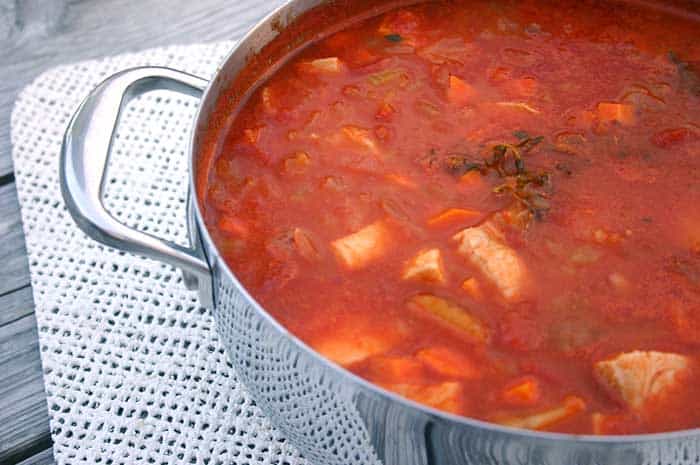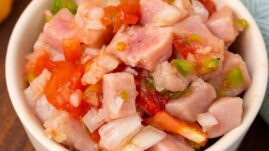This post may contain affiliate links. Please read our disclosure.
This tomato-based mahi-mahi chowder with vegetables and potatoes is simple to make and so delicious! It’s a hearty dish to warm you up on a chilly day.

When most of us think of a flaky white fish, we imagine a light dish that’s perfect to eat when it’s hot outside.
But this mahi-mahi chowder is just the kind of rich and hearty soup to warm you up on a chilly day! Thanks to the vegetables, potatoes, and tomato base, it’s very cozy and satisfying.
By the way, did you know that in North Carolina, mahi-mahi is also called dolphin or dolphinfish? In fact, old-school fishermen and long-time residents still call it that. So if you ever see “dolphin” on a menu in the Outer Banks, don’t panic!
To avoid confusion, I’ll stick to calling it mahi-mahi. I wouldn’t want anyone to miss out on this delicious chowder because of the name!
How to make mahi-mahi chowder
This recipe comes together in just a few simple steps, and you can make everything in one pot on the stove!

Step 1: In a 4-quart saucepan, heat the oil over medium-high heat.
Step 2: When the oil is hot, add the onion, celery, carrots, and potatoes. Sauté for about 5 minutes.
Step 3: Once the vegetables begin to soften, add the tomatoes, water, Old Bay seasoning, and salt.
Step 4: Use kitchen twine to tie together the sprigs of oregano and thyme plus the bay leaf. Add the herb bundle to the saucepan.
Step 5: Bring the mixture to a boil, then reduce the heat to medium-low and simmer for about 15 minutes or until the potatoes are tender.
Step 6: Add the mahi-mahi and simmer until the fish is opaque and just cooked through, about 10 minutes.
Step 7: Add freshly ground pepper and serve immediately.
The trick is to not overcook the fish. You want the mahi-mahi to be cooked through, but still firm. As soon as it turns opaque, it’s done.
Variations for this recipe
I really enjoy the light and fresh flavor of mahi-mahi for this chowder. However, if you’re having trouble finding it, you can always substitute another kind of firm white fish like cobia, grouper, or red snapper.
And if you’re watching your sodium intake, feel free to skip the sea salt in this recipe. I also recommend looking for no-salt-added tomatoes.

Making this chowder ahead of time
This recipe can certainly be made all at once. However, if you’re able to make part of it ahead of time, I think the chowder is much better on the second day once the flavors have had a chance to blend!
If you’re making it in advance, the trick is to only make the base and then refrigerate it overnight. The next day, just heat up the base on the stove, then add the fish and finish cooking.
The base of the chowder can be stored covered in the refrigerator for up to a week. If you have leftovers of the chowder with the mahi-mahi, store them in an airtight container in the refrigerator and eat them within a day or two.
Other seafood soup recipes
From gumbos to chowders, I love making rich and hearty dishes with seafood! They’re perfect to enjoy all year round. Here are a few of my favorite recipes I know you’ll love:
You can also take a look at this roundup of low-carb and diabetes-friendly soup recipes for more inspiration.
Mahi-Mahi Chowder

Ingredients
- 2 tablespoons olive oil
- 1 cup sweet onion, (diced)
- 1 cup celery, (diced)
- 1 cup carrots, (diced)
- 8 small red potatoes, (quartered)
- 28 ounces diced tomatoes, (including juice)
- 3½ cups water
- ½ teaspoon Old Bay seasoning
- 2 teaspoons sea salt
- 1 sprig fresh oregano
- 2 sprigs fresh thyme
- 1 bay leaf
- 1 pound mahi-mahi or other firm white fish, (cut into bite-sized pieces)
- 1½ teaspoons freshly ground black pepper
Instructions
- In a 4-quart saucepan, heat the oil over medium-high heat.2 tablespoons olive oil
- When the oil is hot, add the onion, celery, carrots, and potatoes. Sauté for about 5 minutes.1 cup sweet onion, 1 cup celery, 1 cup carrots, 8 small red potatoes
- Once the vegetables begin to soften, add the tomatoes, water, Old Bay seasoning, and salt.28 ounces diced tomatoes, 3½ cups water, ½ teaspoon Old Bay seasoning, 2 teaspoons sea salt
- Use kitchen twine to tie together the sprigs of oregano and thyme plus the bay leaf. Add the herb bundle to the saucepan.1 sprig fresh oregano, 2 sprigs fresh thyme, 1 bay leaf
- Bring the mixture to a boil, then reduce the heat to medium-low and simmer for about 15 minutes or until the potatoes are tender.
- Add the mahi-mahi and simmer until the fish is opaque and just cooked through, about 10 minutes.1 pound mahi-mahi or other firm white fish
- Add freshly ground pepper and serve immediately.1½ teaspoons freshly ground black pepper



